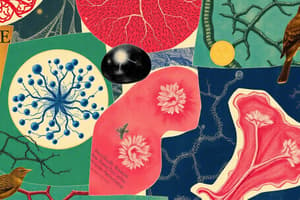Podcast
Questions and Answers
What is the primary function of the Na+/K+ pump in the plasma membrane?
What is the primary function of the Na+/K+ pump in the plasma membrane?
- Provides energy for neurotransmitter release at synapses
- Starts action potentials by depolarizing the membrane
- Facilitates the movement of calcium ions into the cell
- Maintains resting membrane potential by exchanging sodium and potassium ions (correct)
In terms of nerve impulse conduction, what is the main difference between saltatory conduction and continuous conduction?
In terms of nerve impulse conduction, what is the main difference between saltatory conduction and continuous conduction?
- Saltatory conduction requires more energy than continuous conduction
- Saltatory conduction is slower than continuous conduction
- Continuous conduction allows impulses to jump between nodes of Ranvier
- Saltatory conduction occurs only in myelinated axons, whereas continuous conduction occurs in unmyelinated axons (correct)
Which division of the autonomic nervous system is primarily responsible for the 'fight or flight' response?
Which division of the autonomic nervous system is primarily responsible for the 'fight or flight' response?
- Somatic nervous system
- Sympathetic division (correct)
- Parasympathetic division
- Central nervous system
What is the role of cerebrospinal fluid (CSF) in the central nervous system?
What is the role of cerebrospinal fluid (CSF) in the central nervous system?
Which neurotransmitter is primarily released by the sympathetic nervous system?
Which neurotransmitter is primarily released by the sympathetic nervous system?
What is the main difference between afferent and efferent neurons?
What is the main difference between afferent and efferent neurons?
What is the function of the sarcoplasmic reticulum in muscle contraction?
What is the function of the sarcoplasmic reticulum in muscle contraction?
During which phase of muscle contraction does the sliding filament mechanism occur?
During which phase of muscle contraction does the sliding filament mechanism occur?
What describes the resting membrane potential (RMP) in neurons?
What describes the resting membrane potential (RMP) in neurons?
What occurs during rigor mortis?
What occurs during rigor mortis?
Which statement accurately describes the differences between glycolysis in aerobic and anaerobic conditions?
Which statement accurately describes the differences between glycolysis in aerobic and anaerobic conditions?
Which type of muscle tissue is characterized by striations and voluntary control?
Which type of muscle tissue is characterized by striations and voluntary control?
What is the primary function of neuroglial cells in the nervous system?
What is the primary function of neuroglial cells in the nervous system?
Flashcards
Myelinated vs. unmyelinated axons
Myelinated vs. unmyelinated axons
Myelinated axons have a fatty sheath (myelin) that speeds up nerve impulse transmission. Unmyelinated axons transmit impulses slower.
Action potential phases
Action potential phases
Action potentials have distinct phases: Depolarization (Na+ influx), Repolarization (K+ efflux), and Hyperpolarization (K+ channels slow to close).
Saltatory Conduction
Saltatory Conduction
Nerve impulse jumps between Nodes of Ranvier, speeding conduction in myelinated axons.
Resting Membrane Potential (RMP)
Resting Membrane Potential (RMP)
Signup and view all the flashcards
Neurotransmitters
Neurotransmitters
Signup and view all the flashcards
Negative Feedback Mechanism
Negative Feedback Mechanism
Signup and view all the flashcards
Anabolic Reaction
Anabolic Reaction
Signup and view all the flashcards
Action Potential
Action Potential
Signup and view all the flashcards
Muscle Twitch
Muscle Twitch
Signup and view all the flashcards
Sarcoplasmic Reticulum
Sarcoplasmic Reticulum
Signup and view all the flashcards
Glycolysis
Glycolysis
Signup and view all the flashcards
Neuromuscular Junction
Neuromuscular Junction
Signup and view all the flashcards
CNS and PNS
CNS and PNS
Signup and view all the flashcards
Study Notes
Unit 1: Introduction
- Body organization terminology
- Homeostasis: negative and positive feedback mechanisms
- Organelle functions
- Organic molecules: building blocks
- Nucleic acids and protein synthesis
- Cell membrane structure and function
- Cell membrane specializations
- Cell division: mitosis vs. meiosis
- Membrane transport (thorough study)
Unit 2: Tissues & Skin
- Endocrine vs. exocrine glands
- Four main tissue types (structure and function)
- Body membranes (serous, synovial, mucous, cutaneous)
- Integumentary system classification and functions
- Vitamin D: production, function, and importance
Unit 3: Skeletal System and Muscular System
- Bone cells: names and functions
- Bone tissue composition
- Long bone parts
- PTH/Calcitonin: Ca++ homeostasis regulation
- Bone names and basic parts/functions
- Axial vs. appendicular skeleton
- Joint classifications and examples
- Muscular system functions
- Muscle tissue types (structure and function)
- Skeletal muscle organization (sarcolemma, sarcoplasmic reticulum, T-tubules)
- Neuromuscular junction (structure and events)
- Resting membrane potential (RMP)
Unit 4: Nervous System
- Nervous system organization (CNS and PNS)
- Nervous system functions
- Neuron structure and functions (dendrites, soma, axon, axon hillock, terminal)
- Neuron classification
- Neuroglial cell functions
- Afferent vs. efferent (sensory vs. motor) divisions
- Myelinated vs. unmyelinated axons (AP propagation rate)
- CNS: brain and spinal cord (white and gray matter)
- Resting membrane potential (RMP) definition, generation
- Depolarization, repolarization, hyperpolarization
- Action potential definition, generation, phases
- Na+/K+ pump of plasma membrane: function
- Ca++ pump of sarcoplasmic reticulum: function
- Saltatory vs. continuous nerve impulse conduction (rate of AP propagation)
- Synapse types (electrical and chemical)
- Brain divisions, lobes, and functions
- Cerebrospinal fluid (CSF): formation, location, functions
- Blood-brain barrier: structure and function
- PNS: sensory and motor divisions
- PNS: somatic and autonomic divisions
- Cranial and spinal nerves
- Sensation: sensory receptors, receptor potentials, and action potentials
Studying That Suits You
Use AI to generate personalized quizzes and flashcards to suit your learning preferences.




